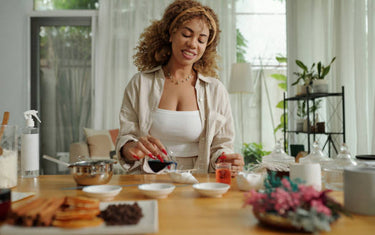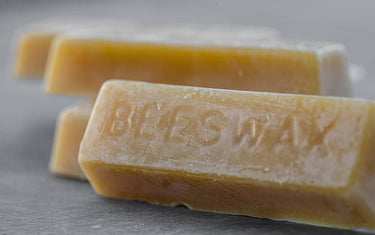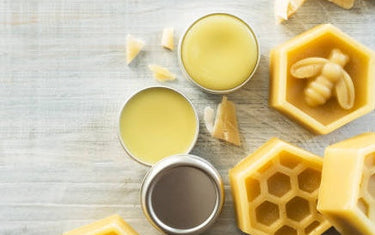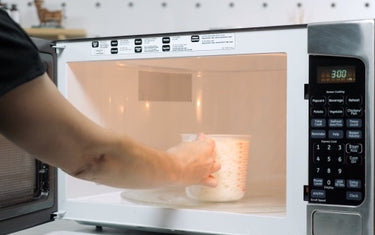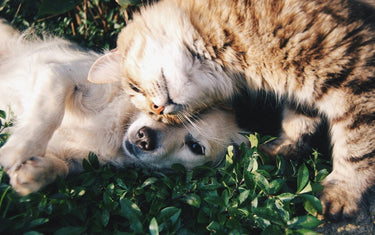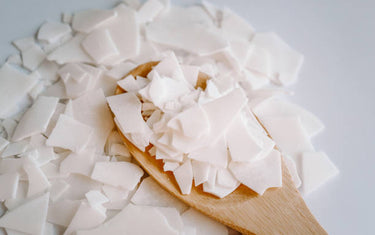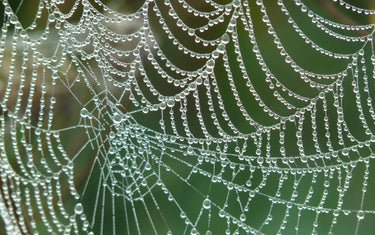7 min read / 29 January 2025 / yasmin sharp
Eco Friendly Candle Making
Learn how to make sustainable candles using natural waxes, wicks, and essential oils for an eco-friendly alternative to traditional candle making.
Share this post
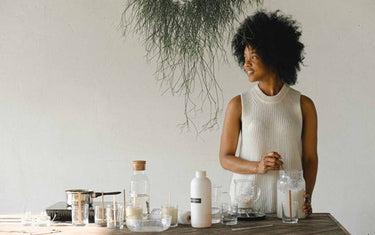
It’s perhaps more important than ever to consider the benefits of using eco-friendly materials and ingredients in your candle recipe.
Most people are aware of the need to become more sustainable and even the smallest changes can have a meaningful impact.
In this article we explain more about how using natural candle making wholesale ingredients and materials can transform your production process, potentially save you money and have a positive impact on the world at large.

1. Use natural waxes for your candles
While paraffin wax can be the easy go-to option, when it comes to making eco-friendly candles there are more sustainable benefits to be gained from using natural waxes.
Paraffin wax is a by-product of petroleum, which isn’t ideal if you are concerned about being green conscious. Whether you buy wholesale wax for your business or want to make your own candles more ecologically sound, you could try:
- Soy wax: This comes from harvested soybeans that have been cleaned, cracked and rolled. Soy wax is biodegradable and a great choice because it is completely soot free when burnt, so no harmful chemicals are released into the air.
- Coconut wax: The sustainable and renewable properties offered by coconut explains why it has grown in popularity in recent years. Coconut wax is extracted from coconut oil and is biodegradable while also offering a clean and efficient burn.
- Beeswax: As the name suggests, this comes directly from beehives, which makes it a natural and sustainable choice. Beeswax candles are also soot free and tend to burn for longer – just to be careful to buy from suppliers who use sustainable harvesting practices.
2. Switch from synthetic wicks to natural wicks
If you are migrating to eco-friendly candle making, then you may also want to consider making the switch from synthetic wicks made from nylon or zinc to natural wicks.
There are a few different materials you can use that won’t affect the quality of your craft – and can even enhance it in some areas.
- Wooden wicks: Wood is renewable and biodegradable, which makes the wicks perfect for making eco-friendly candles. People love the fireplace-style crackling sound produced by the burn, while the material also releases fewer soot emissions.
- Cotton wicks: This is 100% natural, and the most common type of wick used for scented candles. The material is environmentally friendly, durable and easy to light and also produces a nice slow, steady burn.
- Linen wicks: Linen wicks have a similar composition to cotton wicks, which also relates to their environmental benefits. They produce a cleaner burn and are biodegradable, while also working well with plant-based waxes.
3. Include natural fragrances in your candle recipes
Eco-friendly candle making involves using natural fragrances that are less harmful to the environment while also providing potential health benefits for users.
Essential oils are the best option for making sustainable candles, as they are extracted directly from plants, flowers and fruits and should not contain any additional ingredients.
The natural properties contained in essential oils have the potential to:
- Calm and ease stress levels
- Improve sleep
- Kill certain bacteria, fungi and viruses
- Reduce inflammation
- Boost energy levels
- Relieve nausea and headaches
- Treat mild skin conditions
Investing in candle making wholesale supplies can help to cut costs and increase your profit margins, especially when it comes to essential oils. If you want to improve your green output and scale up your product offering, then you might want to consider buying the oils in bulk.

4. Dye your candles using natural ingredients
Not everyone adds colour to their candles, but for those that do, this is another part of the process that can be made greener and kinder to the environment.
These types of dyes tend to work best with soy, palm and beeswax, so if it’s something you’ve never tried before, here are a few suggestions:
- Yellow colours: Using turmeric, annatto seeds or even lemon peel (separately), can create a rich yellow to yellow-orange colour on the wax.
- Red colours: Alkanet root and rosehips are popular choices for turning the wax red, which can give your products a strong pop of colour.
- Pastel/beige colours: Vanilla pods, madder roots and chamomile flowers add light browns, warm beiges and pale peach tones to the wax.
Natural colouring needs to be done in a very specific way (using a tea bag or coffee filter) so look for recipes that can give step-by-step instructions on how to do this.
5. Wrap your products in eco-friendly packaging
If you’ve gone to all the effort of changing the wax, wicks, fragrances and dyes used in your candles, it makes sense to look at the benefits of using eco-friendly packaging:
- Cardboard candle packaging: Cardboard is biodegradable and recyclable, so if you want to move away from plastic packaging, this is a great place to start. And not only is it a more sustainable option, but it has a more environmental aesthetic, with its warm, earthy tones allowing you to present the right image for your brand.
- Glass vessels: Metal tins are often used for candle packaging but because many are lined with plastic to prevent corrosion, this can make them trickier to recycle. Glass on the other hand is much more straightforward to recycle and can easily be reused by customers as plant holders, décor pieces or just for storage.
- Kraft paper wrapping: Kraft paper comes from wood pulp, a renewable source, and requires fewer chemicals to make it than most other types of manufactured paper. Recycling isn’t an issue, and it is also biodegradable, so it can have less of an environmental impact after disposal.
Reduce waste during and after production
Keeping on top of waste management during and after you have finished a candle batch can boost your sustainability and help you get more from your materials. For instance, you could:
- Recycle and reuse material as much as possible, which will help to save you money in the long run. For example, reusable equipment and containers can lower production costs or you could use wax scraps to make wax melts and other products.
- Use sustainable ingredients like essential oils and natural dyes. Even better if they are compostable and/or biodegradable, as this reduces any potential damage they
- Closely monitor how you measure and use ingredients during the production process. The more accurate you can be, the less waste will be produced, so you can get more out of your wax, wicks, fragrances and dyes.
- Make larger batches as this can reduce the amount of waste left over at the end. Buying candle making wholesale ingredients often makes financial sense too, as you can get a better price per unit, with bigger savings available the more you buy.
- Be careful of ordering too many ingredients and materials, and only order what you need. It’s good to stock up and plan ahead, but only buy based on what you currently sell and what you are projected to sell in the near future.

How to make eco-friendly candles
Now that you’ve learned more about the benefits of using natural wholesale wax, wicks, dyes and fragrances, it’s time to put it into action.
Below is a simple recipe for making natural candles that are kinder to the environment.
You will need
- Natural wax of choice: soy, coconut, beeswax or palm wax flakes
- Natural candle wicks: cotton, linen or wooden
- Essential oils of choice (30-35 drops per 160g of flakes)
- Reusable candle container (glass is ideal)
- Natural colour dye (based on the colour you want to achieve)
- Saucepan
- Thermometer
- Glass bowl (large enough for only the base to sit inside the saucepan)
- Glue dots
Method
- Fill the saucepan about halfway with water and heat gently until it simmers.
- Place the wax flakes into the glass bowl and place it on top of the saucepan, ensuring the base does not touch the water.
- Melt the wax and use the thermometer to ensure it does not exceed 80°C.
- Add the glue dots to the metal stabilisers at the bottom of the wick and stick to the centre of the candle container.
- Wrap the wick around a pencil so it remains in place, and trim it so it is 3-4 inches higher than the top of the container.
- Once the wax has melted, let it cool to 65°C and add the essential oils and any natural dyes you are using. Stir and blend together with the wax.
- Transfer the wax into a jug and carefully pour into the candle container – keep a close eye on the wick to ensure it remains securely in pace.
- Leave the candles to rest for at least 24 hours. Once the wax has set, trim the wick down to 2 cm above the top of the wax.
- The candle is now ready to be sold or for use around your home!

Final thoughts
Making the switch to eco-friendly candle making requires you to rethink how you create your candles.
Consider the types of wax, wicks, fragrances, dyes and packaging you use and see where you can make any changes.
You don’t have to do it all at once, especially if you have existing supplies to work through, but as your candle making evolves to become more sustainable, hopefully you’ll see the cost-saving benefits and how you can add even more value for your customers.
It’s important to get your candle making wholesale ingredients from a responsible supplier that follows sustainable practices. At Nikura, all our essential oils are 100% pure and natural, vegan friendly and cruelty free.
You can sign up for our wholesale service to enjoy exclusive discounts and access to high-quality wax, dyes and essential oils that can make your products more eco-friendly.



